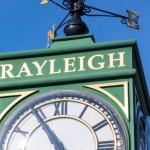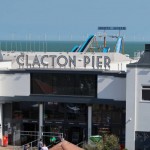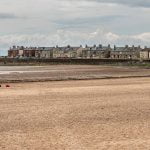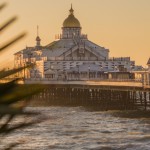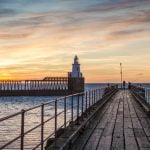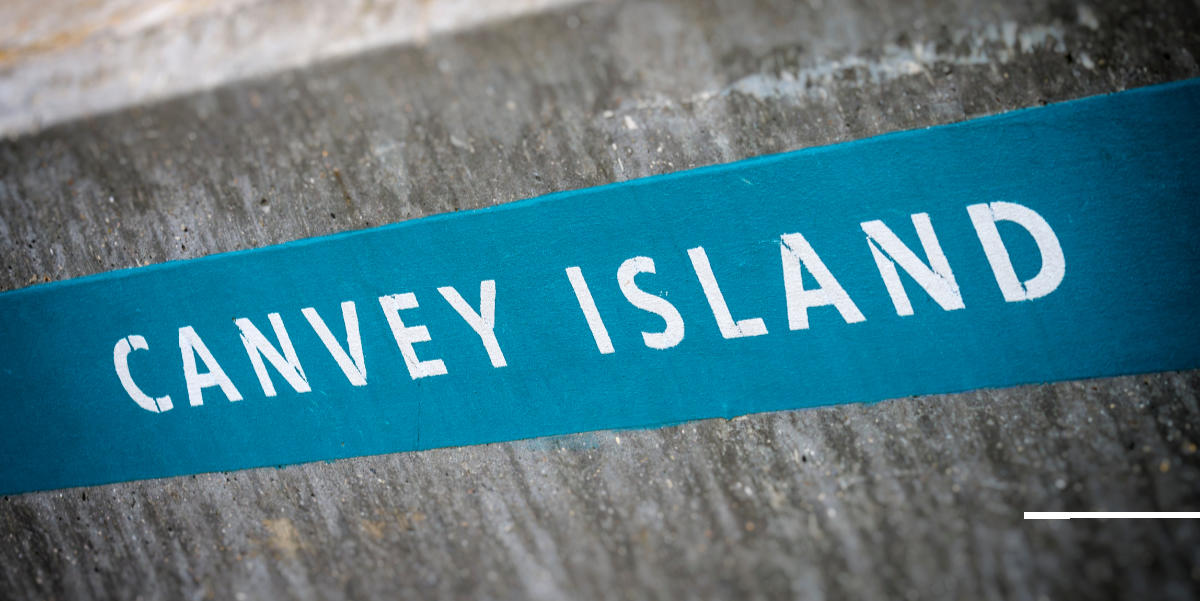
Canvey Island London’s favourite beach destination since the mid 1800s!
Canvey Island has been a favourite holiday hotspot for generations. Many of us have fond memories of time spent on Canvey beach. Featured in White’s Directory of Essex in 1848, Canvey Island had only minimal residents and appeared to be a holiday destination only. Londoners flocked here when the train lines arrived in the 1840s, establishing it as a staycation town locals and tourists love. Two hundred years later, we are still flocking to the beaches of Canvey Island come July and August.
Interested in taking a peek back through the years? We certainly are. Here is the Five Minutes Spare guide to the UK’s fondest beach vacay spot. Here’s everything you ever wanted to know about the fabulousness of Canvey Island in one spot.
Canvey Island Early History
Canvey Island is bang-slap in the middle of the Thames Estuary, just off the east coast of Essex. Archaeologists estimate that the island has seen occupation since the Iron Age, with trinkets found here and there over the years. This civil parish sits just outside of Southend on Sea, with excavations dating the earliest man-made objects here to Roman times. The Romans looked at the position of the island and knew it was a good place to establish their first line of defences.
Between AD 50 and 250, built several structures on the island. Asides from the Iron Age axes and Bronze Age tools found here, the Romans left behind evidence of a garrison, a healthy food farm, and an established salt-making operation. Canvey Island has what we call ‘Red Hills.’ These are created from the smashed up clay compounds that were involved in processing the salt. South-East of England has lots of these structures.
Roman Canvey
The island has a Roman Road which connects it to Benfleet which runs across the River Thames. This would allow the Romans to purvey their salty wares north in Chelmsford and Colchester. Several pieces of pottery and even glassware have been found along this stretch.
Historians believe the town got its name from Caningaege, which means ‘the island where Cana’s people live.’ This goes with the idea of it being an estate or manor area for a Viking or Saxon lord.
Although we couldn’t find any formal mentions of Vikings on Canvey Island, it would make sense that they landed here. It’s offshore, perfect for raiding parties, it could house their ships, and it is just off the coast in the richest part of the UK. After the Romans retreated, they took most of the population with them, leaving England peppered by ghost towns. Canvey Island has a ‘Vikings Way’ in its centre, named for the occupiers. There is also a book by Richard Mayne about the Canvey Island Viking. We are not sure how much of this is based in fact.
Medieval Times on Canvey Island
By the time the Saxon and Angle period rolled around, the Canvey Island occupants appear in the Domesday Survey. This survey occurred thanks to King William the Conqueror in 1086, twenty years after the formal Norman Invasion took place. In this book, the author describes Canvey Island as a sheep farming area that nine different villages shared. This means that the Vikings and the Romans both abandoned the area, not seeing the potential for growth and holidaymaking goodness. They made cheese from the milk and ate mutton, instead. The cheese sheds that you can still see on the island prove that early Saxons lived here, at least for long enough to build their signature cheese houses.
By the 12th century, the area inherited the name Caningaege, which later changed to Caneveye when it changed hands into the possession of Henry de Essex. Before that, it was the property of Swein, son of Robert Fitz Wymarch.
Henry II took the land from de Essex at some point in the 1100s to give it to the king’s favourites. His successor placed the land into the hands of John de Apton, who reported continuous flooding which made it near worthless. A small population and some sheep were all he could keep on it. By 1607, historic accounts note that the hills were the only parts routinely out of the water and that the sheep flocked there every time it rained. These hills, of course, were the red hills from salt making.
The antiquarian William Camden mentioned Canvey Island in his work Britannia. Camden noted that the Alexandrian geographer Ptolemy recorded Canvey Island in his work, Geographia. Later, White and Yearsley would note that parts of the island fell into the sea.
Fun & Not So Facts About Canvey Island
At this point in any given travel guide, we like to stop and review what the fun trivia is from the area. Sometimes we dig up great stuff, sometimes we find really macabre things that have happened in the area. Here’s everything the Five Minutes Spare team could dredge up about Canvey Island, England:
- Canvey Island is actually below sea level!
- The Island as we know it is the result of around 300 Dutch workers who built the initial flood defences to reclaim the surrounding land in 1622.
- The Colvin Bridge was built in 1931 connecting the island to the mainland. Prior to this Horses Cattle and even cars were often swept away by fast incoming tides.
- A storm flooded part of the island in 1953 resulting in 58 deaths. of several islanders and the evacuation of the then 13k residents.
- The Red Cow pub was spared flooding in the above event and was later renamed The King Canute for obvious reasons.
- Canvey Island is the site of the world’s first terminal for imported natural gas, built-in 1959.
- In 1901 the population was around 300 while today it is around 40,000 and rising.
- The island only covers 7.12 square miles and thus is now pretty much urbanised.
Now that’s out of the way, let’s turn our attention back to history. Where were we again? Oh, that’s right, onwards with the Industrial era.
The Industrial Revolution in Canvey
During the Industrial period, the town started its journey towards huge growth. Just before the beginning of this era, Dutch haberdasher Joas Croppenburg decided he wanted to live there. He offered himself and his relative’s services to build flood defences on the island. He reached an agreement with the owner of the land to rebuild flood defences in exchange for the islanders owning a share of the island. The project went ahead under the guidance of Dutch engineer and cousin of Croppenburg, Cornelius Vermuyden.
The project saw the seawall repaired. Three hundred skilled Dutch workers built sea defences and raised dikes. Those who are unfamiliar with the Netherlands might not realise that the land is entirely flat. Dutch engineers have been keeping Amsterdam above water since the get-go. They successfully reclaimed 3,600 acres of land on the island. They drained the fens area, walled the island up with locally mined chalk and heavy marsh clay, and fronted it with Kentish ragstones. They dug a huge drainage ditch and several sluices. As a result, one-third of Canvey island became Dutch. To this day, the street names and population reflect this.
Slow Growth
Canvey Island didn’t have an industrial revolution as such, it had a steady period of slow growth after the Dutch workers built it. In 1851, locals erected the Canvey Lighthouse to stop fisherfolk from becoming trapped in the salt flats. There are shallow waters outside of the island. Joseph Conrad later mentioned the house in his work Heart of Darkness. Locals tore down the lighthouse in 1958 because it was a health hazard.
During the 1800s, the local Lobster Smack Inn was the home of several fistfights. These were events rather than random bouts. Events lasted until someone won. The longest recorded fight was between Aaron Jones and Tom Sayers. It lasted an impressive 3 hours and sixty-five rounds. There was even a rematch a few months later in London because it was so epic. Sayers won the rematch but the first fight was a draw. In 1853, another fight lasted sixty rounds. One of the men was knocked down fifty-nine times before the other was satisfied that whatever grievance was between them was settled. The history books report they settled the dispute with a handshake, even after all that trouble.
In 1867, the town records mention an officer, nine men, and a chief sailor, who were there in preventive service. The Preventive Men lived in seafront cottages. The history books later mention the Lobster Smack Inn again, this time as a place behind the seawall where smugglers would use. The cottages are still in use to this day.
20th Century Canvey Island
Canvey Island was a popular place to visit in the late Victorian and early Edwardian eras. Sea bathing had increased in popularity thanks to the royal family’s indulging and a number of entrepreneurs tried to build on this. One entrepreneur bought Leigh Beck Farm and turned it into the Southview Park Estate. He sold the properties so fast that he returned to buy more plots. They built dream holiday homes and sold them to wealthy Londoners. The monorail also opened around this time.
Modern Times
After the monorail opened at the turn of the century, the island was well-established as a tourist destination. A new seafront followed in the 1930s. Canvey Casino opened at around the same time. An earlier auction at Chimney’s farm meant Hester’s lands returned back to the islanders. Over the following few years, the island worked hard to recover its reputation as a staycation destination for day-tripping Londoners. A cinema opened in the 1900s, as did several pubs, bars, restaurants, and the club: the Goldmine. The town was a popular holiday destination up until the 1970s when the foreign holiday replaced the homestay as the preferred destination.
Famous People from Canvey Island
Whether you live on Canvey Island, or whether you are just trying to spot celebrities while they are staying in local hotels, here are the famous faces you might see here:
- Lee Brilleaux of Dr Feelgood came from here
- Peter Green, of Fleetwood Mac, came from Canvey Island
- Footballer Ty Gooden lived here
- Wilko Johnson from the Blockheads was born on Canvey Island
- Lew Lewis, who guested with the Stranglers and the Clash as a harmonica player, came from here.
As you can see, you might bump into about anyone at the supermarket. Let’s leave off the famous people and push on with the part you’ve all been waiting for. What are the biggest and best attractions in the area and where do you find them? Let’s find out.
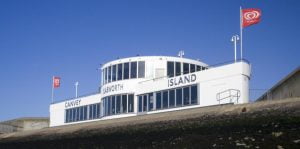
Image Sue Chillingworth?shutterstock.com
Tourist Attractions on Canvey Island
We wouldn’t be Five minutes Spare if we weren’t examining each town guide from all angles. One of our favourite things to report on is what there is to see and do in an area. If you are on Canvey Island in the near future, try and see some of the following sites.
Historic Sites and Landmarks
A local landmark is West Canvey Marsh, which has been taken over by the RSPB. You can go birdwatching here, enjoy the usually grim weather, and the car park is free. There are a few walking trails around here, but please stay on the path for the sake of the birds. The combination of salt marsh, scrubland, and meadow, means there are birds here you don’t get in other places.
If you don’t mind travelling a little farther to the west, you can visit the historic Hadleigh Castle. This castle has free entry, even although Historic England runs it now. The castle opened in 1215 after Hubert de Burgh commissioned it. It sports a barbican and two gun towers, perfect for hunting smugglers from the top of the walls. The barbican and towers were already standing when the castle opened. The buildings were opened in 1360 by King Edward to protect his lands. Nowadays it’s a great place to wander around. Enjoy the views, take in the gardens, and don’t scrimp on the picnic.
Galleries and Museums
Undoubtedly the best museum in town, the Canvey Island Transport Museum is a big hit among old folk and kiddies. The kids like to take a turn pretending to drive the trains and the buses, while the old folks look at the double-deckers with fond remembrance. The Transport Museum features trams, old cars, a few vans and if you’re lucky, a train or two. Whatever you do on Canvey Island, this is the place you want to see. You won’t forget sitting in an open-air bus with a beautiful sea view in a hurry.
Although not technically a museum, it has the same feel to it. Head over to the Canvey Island model railway and engineering club on a Sunday afternoon. They will show you their excellent giant miniature railway and train sets. Volunteers run the place and they engage in a labour of love. If you love trains too, you will fight right in. You might even get to ride one.
Canvey Island has a long and unique history of Dutch occupancy. To this day, you can still attend one of the original cottages that they created on the seafront on Canvey Island. These cottages are a distinctive shape, almost similar to the old Saxon roundhouses. The exhibit includes a fully functioning room as it would have stood in the 16th century. Castlepoint runs it as a museum. It’s the cottage that opened in 1621 and belongs to private owners. Numerous Dutch workers and their families would live in these over the years. Remember, a whole third of the town was Dutch at one point.
Outdoor Attractions
One of the biggest attractions on Canvey Island is the Leisure Island Fun Park. This place contains rides, a 3D exploration online, swings and roundabouts but, and numerous arcade game areas and little person adventures. The fun park is unmissable, situated right on the seafront. It contains everything you would expect, inclusive of candy floss and teacup rides. There’s a teeny tiny rollercoaster for the kiddies and even go-karts.
You can’t come to Canvey Island and not spend time on the beach. This beautiful seafront area features a stretch of sandy beach complete with shells, sea glass, and even the odd piece of seaweed. Everyone loves a trip down beyond the sea wall. Take some fantastic pictures or enjoy a relaxing time building sandcastles. Canvey Beach has it all. If you’re not satisfied with the views from Canvey seafront, check out the views across the water from Thorney Bay Beach, instead.
Last on our list of outdoor attractions you really ought to see on Canvey Island, is the Canvey Heights Country Park. This place lets you get closer to nature, returning to your roots with seabird information, seals, and more. You’ll find this park off Creek Road and you can access it without paying for it. It’s one of the few places on the island that don’t want you to fork out money for the experience. Enjoy the walks, hikes, and biking routes found throughout.
Sports and Recreation
Recreation doesn’t get any better than the Stay and Splash found over near the Paddocks Lido. It’s not really a swimming pool, though it is. It’s not really a play park, though it is. It’s the kind of place you let the kids run riot until they are tired enough to go to bed when you go back to your accommodations. It’s definitely fun, whatever it actually is. You should schedule a visit if you are on the island this summer.
Canvey Island has its own skatepark, which is exceptionally rare for the southeast of England. Go along on holiday and take your board with you.
There is a golf course near the town, too. You can visit the Castle Point Golf Course to enjoy a few rounds while you are on your break.
Canvey Island has both their own football club and their own rugby club for your enjoyment. Go along and catch a match or game, or just take a tour of the grounds. You can find them practising most days a week at Park Lane.
Shopping and Retail
There are some great shops on Canvey Island, certainly enough to give you groceries. Shop at the Knightswick shopping centre for all your clothing and fun shopping needs. There’s a Marks and a Peacocks too, should you need new clothes.
Other Notable Attractions
If you have come this far, you must live there. Nobody else would go to this much trouble figuring out things to do in Canvey Island if they weren’t a permanent resident. Here are a few things you can do in the surrounding area if you are staying for any longer than a week or two:
- Visit the Bright Angel Lodge Spiritual centre.
- Take a lesson at the Essex Powerboat School. What could possibly go wrong?
- Go to the Movie Starr Cinema.
- Visit the haystack or the corner club.
We are at the end of our guide to Canvey Island. Let’s finish things off with a reminder of who we are and a quick glance at some useless directions.
How to Get to Canvey Island?
If you need to get to Canvey island, try the following directions. Do not blame us if you get lost. We warned you they were bad.
By Road
Follow the A13 out of London until Gray’s and head even farther east.
By Rail
Look for the Benfleet station.
By Air
The nearest airport is London Southend.
By Sea
Sail up the Thames a little to find Canvey.
Got Five Minutes Spare?
If you enjoyed this tour guide to a local English town, then you’ll be delighted to know how many more of these we have on our website. Head over to Five Minutes Spare for more or follow us on Facebook for all the world news and events you need in your life. If nothing else, we can talk you through a good holiday in England this year.
